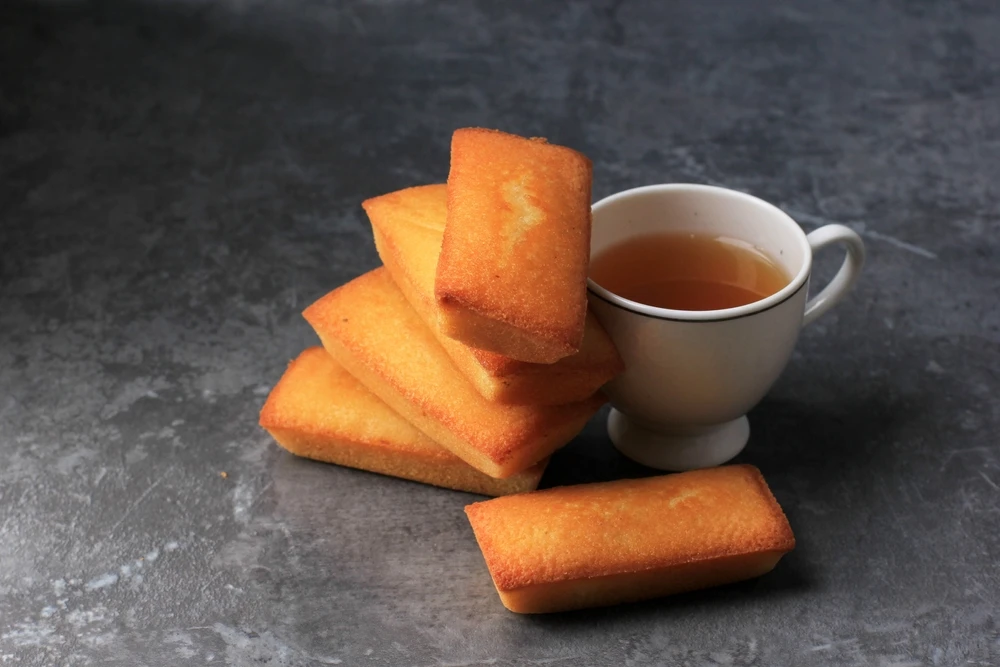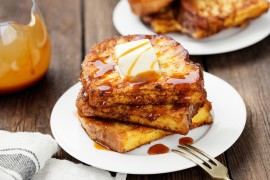Financier : An inventive pastry chef near the Paris Stock Exchange.
Mr. Lasne had a store near the Paris Stock Exchange. There, one could meet financial professionals who were looking for something to eat quickly. The pastry chef Lasne played the game to the end because he gave his cakes a bullion look. If he created the financiers for the name and the shape, Mr. Lasne did not invent the recipe at all.
It was originally a Lorraine recipe from Nancy:
He took a recipe straight from Lorraine, from Nancy, a delicious cake that we still come across in Lorraine called the visitandine since it was invented by the nuns of the Visitation whose convent was rue de la Visitation. According to some sources, this recipe was invented during the Renaissance, and allowed the nuns to have a little bit of delicious food, as they were not allowed to eat meat. However, the story is far from being sure.
Un financier / Image par Ika Rahma H/Shutterstock
Easy financier recipe: step-by-step instructions
ingredients for 6 people
- 4 egg whites
- 40 grams of flour
- 80 grams of powdered sugar
- 100 grams of almond powder
- 100 grams of butter
The process
- Start by preheating your oven to 180 °C
- Melt the butter in a saucepan until it gets colored. As it will smell a bit nutty you will know that you have made a nutty butter.
- Put it aside
- In a bowl, you make your dry mixture by putting the almond powder, flour and powdered sugar together.
- Then, beat your egg whites with a pinch of salt. By hand is best. You don't beat them until they are stiff, but rather "tight".
- Add your egg whites to the dry mixture and mix.
- To this mixture, add the hazelnut butter and mix again (and well). You should get a very homogeneous paste.
- Put the result in the financial moulds - or make a cake, but you will have to bake it longer.
- Bake for 15 minutes at 180 °C
- Turn out and enjoy cold or warm.
Tip: you can perfectly replace the almond powder by hazelnut powder, or make half and half almond powder and hazelnut powder. It is also very good by adding fruits or candied fruits. Some people even make chocolate financiers.
Our translator claimed to have a great command of English because he lived in London for a week. We don't dare to tell him that this is not enough and that he makes mistakes in translation. We apologize for his mistakes but he is so nice.
Tips for making the perfect financier
To make a financier that is both crispy and melt-in-the-mouth, keep an eye on the baking time: it should be golden brown around the edges and soft in the center. Use well-filtered brown butter to develop the flavors, and preferably freshly ground almond powder for more aroma. If you want an original touch, add some citrus zest or fresh fruit to the batter before baking.
FAQs about financiers
What is the origin of the financier?
The financier is descended from the “visitandines,” small cakes created by sisters of the Visitandines order in the Middle Ages, then revived in Paris in the 19th century under their current name.
Why is this cake called a “financier”?
Its name comes from its rectangular shape, reminiscent of a gold ingot, and its popularity with financiers in the Bourse district of Paris.
Can financiers be made without a special mold?
Yes, you can use small muffin or madeleine molds, but the traditional rectangular shape is reminiscent of the origin of the name.
How should homemade financiers be stored?
Keep them in an airtight container at room temperature, where they will stay moist for two to three days. You can also freeze them to keep them longer.





